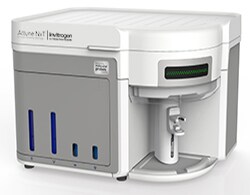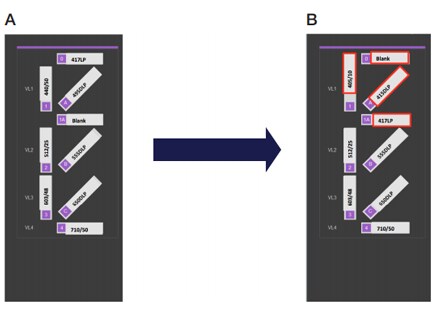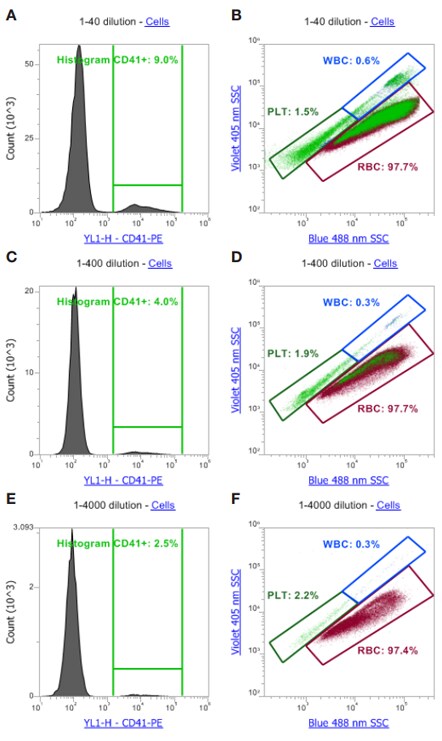Search
利用 Attune NxT 流式细胞仪检测全血中的血小板

简介
血小板是在外周血中循环的无核细胞片段。它们来源于巨核细胞,对于维持稳态至关重要。血小板功能的改变与一系列临床疾病有关,包括 Bernard – Soulier 综合征 (BSS) , Glanzmann 血小板无力症和血小板储存池缺乏 [1]。通过流式细胞术监测血液中血小板的数量和功能可提供有用的诊断和预后信息 [2]。血小板减少症是指循环血液中血小板大量减少,可导致过度出血。相反,以血小板过度激活为特征的疾病可导致血栓形成和相关心血管并发症,包括心肌梗死和脑卒中 [3]。除了在止血方面发挥重要作用外,血小板还能通过释放细胞因子、生长因子和储存颗粒中的蛋白酶来调节血管内皮通透性和白细胞外渗 [4]。越来越多的证据表明,血小板可通过其表面表达的 Toll 样受体 4(TLR4)直接调节先天免疫细胞的信号传导,并介导对病原体的识别 [5]。基础、转化和临床研究人员正在研究血小板在止血和血栓形成之外的作用,例如在炎症、免疫反应、伤口愈合、血管生成、转移、抗菌活性、巨核细胞生成和血小板生成等领域,以及干细胞替代和血小板输血等疗法中的作用 [6]。
静止血小板直径为 2-3 µm,是外周血中最小的细胞成分。在外周血中,它们的浓度范围为 1-3 x 108 个血小板 /mL。激活后,血小板细胞表面受体表达迅速发生变化,导致粘附性改变和形态变化,从而促进血管破裂处形成血小板凝块 [7]。特别是在光散射检测的情况下,这些特性使得通过流式细胞术检测血小板变得具有挑战性。CD41 (糖蛋白 IIb) 是介导细胞 - 基质相互作用的整合素受体家族的成员 [8] ,是流式细胞术中识别和研究血小板最常用的标记物之一。
通常在富含血小板血浆(PRP)中研究血小板,因为血小板在血浆中占主导地位,仅通过光散射特性即可进行识别。然而,制备 PRP 的过程需要大量处理样本,这可能会影响血小板的健康和功能,这是该方法的一大缺点。其他常见的血小板研究方法包括选择性裂解等,用于去除样本中的红细胞(红细胞)。通过氯化铵或类似的渗透处理使红细胞裂解,仅通过光散射来区分血小板,红细胞的细胞碎片会与血小板重叠并使其模糊,从而造成混淆。从样品中去除 红细胞 的处理也可能对血小板的健康和功能产生不利影响。在完整全血中检测血小板是可取的,因为只有最小的样品操作有助于将血小板保持在健康,非活化的状态。然而,由于红细胞的数量比血小板多一个数量级,并且红细胞的非球形形状产生的广泛散射分布可能会与血小板重叠,因此分辨血小板群是一个艰巨的挑战。
本应用说明介绍了使用 Invitrogen Attune NxT 流式细胞仪检测人血中血小板的两套不同方法。第一种方法(方法 1)在裂解的全血中使用 CD41 免疫表型。该方法在检测血小板时同时使用前向散射(FSC)阈值和荧光阈值。第二种方法(方法 2)是一种新的技术,只需对未经处理的血液进行少量样本处理,即可利用双激光光散射法区分血小板、红细胞和白细胞,从而检测血小板。双 FSC 和侧散射(SSC)阈值以及使用藻红蛋白(PE)抗 CD41 抗体的荧光阈值均用于检测血小板。使用后一种方法,无需使用 CD41 等标记物,即可通过全血中的双激光光散射技术识别血小板群。包括 Attune NxT 流式细胞仪在内的大多数商用流式细胞仪的默认阈值通道都是 FSC。使用 FSC 的常见做法在很大程度上是该通道多功能的结果,在白细胞分析中排除小颗粒,包括血小板和碎片。这一特点尤其适用于裂解血,因为即使在洗涤后, 红细胞 裂解的小颗粒也大大超出了待分析的细胞数。
在使用血小板或其他小颗粒的散射阈值时,通常最好使用SSC或SSC和FSC的布尔组合来区分血小板、碎片和仪器噪音。在任何一种情况下,都必须注意不要将细胞事件排除在分析之外。对于小颗粒,FSC 比 SSC 更易受背门自发荧光的影响,鞘液中的小颗粒对信号的影响更大。有小散射信号时,这种噪音可能足以使光源控制器 (FSC) 设置阈值变得更困难。
材料和方法
- 从健康供体采集的全人外周血,用柠檬酸钠抗凝剂收集
- 改良的 HEPES 缓冲酪醇溶液;分装在– 20°C 温度下储存;在– 20°C 温度下可稳定保存长达 1 年:
- 10 mM HEPES 缓冲液,pH 7.4
- 137 mM NaCl
- 2.8 mM KCl
- 1 mM MgCl2
- 12 mM NaHCO3
- 0.4 mM Na2HPO4
- 0.35% 牛血清白蛋白 (BSA)
- 5.5 mM 葡萄糖
- 高得率裂解液(货号:HYL-250)
- Gibco Earle's 平衡盐溶液(EBSS)(货号:14155-063)
- Invitrogen 小鼠抗人 CD41-PE ,克隆 VIPL3 (货号 MHCD4104)
- Attune NxT 流式细胞仪,标准 4 激光器配置 (货号 A24858)
- Invitrogen Attune NxT 免洗涤、免裂解滤光片套件(货号:100022776)
- 12 x 75 mm 圆底管
方法 1:裂解全血检测 CD41+ 血小板 (裂解 / 免洗涤)
样品处理和抗体标记
- 全血在采集后 1 小时内进行处理,以避免因血小板激活而产生伪影。
- 全血在改良 HEPES 缓冲 Tyrode 溶液中以 1:10 的比例进行稀释,并轻轻倒置混合。
- 在室温下,将100 μL 稀释的全血吸管移入圆底试管中。
- 根据厂家提供的说明书加入小鼠抗人 CD41-PE 抗体偶联物,并轻轻混合。
- 样品在室温下避光孵育 20 分钟。
- 向每个试管中加入 2 ml de1高得率裂解液,并在室温下孵育 10 分钟,以便使红细胞裂解。最终稀释比例为 1:201。
- 混合样品后立即在 Attune NxT 流式细胞仪上进行分析。
流式 细胞仪数据采集
- 使用标准 488 nm 激光收集 FSC 和 SSC 数据。
- 使用 561 nm 激发波长和带通的 YL1 检测器收集 PE 数据。
- 使用了三个图解:FSC-H 与 SSC-H 散点图; CD41 荧光与 SSC-H 点图;以及 CD41 荧光的单参数直方图。所有图都使用对数标度。在直方图中, CD41+ 细胞群上放置了一个标记,以包括阳性 PE 事件,并显示阳性事件的百分比。在 SSC 与 CD41 荧光散点图中划分了两个区域 - 一个区域包括标记为 CD41+ 和有色蓝色的 PE 阳性事件,另一个区域包括不属于碎片或仪器噪声的 PE 阴性事件,并呈红色。该图中的颜色背门用于在 FSC 与 SSC 散点图上显示 CD41+ 事件(蓝色)和白细胞(WBC)事件(红色)。
- 收集时采用 25 µL/min 的样品流速,停止标准设置为 10,000 个 CD41+ 事件。
- 收集样品时采用一系列 FSC 阈值和 YL1 荧光阈值,以确定最佳采集条件。
裂解/不裂解方法的数据分析和结果
首先分析用抗人 CD41-PE 抗体偶联物标记的样品,以识别阳性标记的血小板,并调整检测器电压和阈值设置。阈值设置允许用户设置最低信号水平,以同时在多达四个检测器中消除不需要的事件。还可以使用布尔运算符组合多个阈值。
请参阅 Invitrogen Attune NxT 软件用户指南 (出版物编号 100024236) ,以了解有关阈值设置的详细说明。为了区分血小板与碎片和仪器噪音,将FSC阈值调整为 0.5 到 5.0 之间 (图 1)。单独使用 FSC 阈值不足以通过散射光区分血小板和碎片。FSC / SSC 散点图显示了重叠细胞碎片群的血小板群,不同于仪器噪声和白细胞。增加 FSC 阈值确实消除了很多仪器噪声,但单靠散射仍然无法区分血小板与碎片。利用双参数荧光与 SSC 图,将 CD41+ 事件与碎片分离。白细胞在散点图和荧光与 SSC 点图中都可见,在两种情况下,白细胞都很容易与血小板和碎片区分。较小的白细胞(淋巴细胞)群可能与 SSC 参数中的血小板群重叠,但它们很容易与FSC中的血小板和碎片区分开来。通过调整 0.1 到 5.0 之间的荧光阈值,可以确定最佳设置,从而消除不必要的非荧光事件,区分 CD41-PE 标记和碎片,并在散点图中识别血小板群(图 2)。在理想情况下,使用荧光阈值时,检测到的唯一信号来自荧光参数,并且可以看到全部群。本例中的最佳荧光阈值设置为 1.0。当使用这一荧光阈值设置时,可区分 CD41+ 血小板和碎片,且可以看到全部荧光 CD41 群体。在 0.1 的最低荧光阈值设置下,可见大量的仪器噪声和碎片。将荧光阈值增加至 0.2 ,可部分消除仪器噪声和碎片。在最高的荧光阈值设置 5.0 时,虽然消除了仪器噪音和碎片,但血小板群被截断。
图1.裂解全血中的血小板检测:使用 FSC 阈值。(A, B和 C) 当使用 0.5 的 FSC 低阈值时,可通过仪器和 / 或检测器噪声以及细胞碎片进行准确的血小板检测。(D, E和 F) 或者, 将FSC 阈值增加至 5.0 也可提高 CD41+ 血小板群体的分辨率,因为分析中消除了仪器噪声。然而,即使是将FSC 阈值设置为 5.0 ,也不能从分析中完全去除碎片,并且单用 488 nm 光散射无法完全从碎片中分离血小板。
图 2.裂解全血中的血小板检测:使用荧光阈值。(A, B和 C) 在最低 YL1 阈值设置为 0.1 时,在所有三个图中都检测到大量的碎片和仪表噪音。(D, E和 F) 通过将 YL1 阈值增加到 0.2 ,可以从分析中排除碎片。这样,我们就可以只收集CD41+群的数据。(G, H和 I) 最佳 YL1 阈值为 1.0 ,消除了仪器噪声和大多数碎片,因此可见的主要群体是荧光 CD41 血小板。(J, K和 L) 将 YL1 阈值进一步增加至 5.0 ,会截断血小板群体,但阈值过高。
方法 2:CD41+ 血小板完整全血检测(无裂解/免洗涤)
样品处理和抗体标记
- 采集后 1 小时内处理全血,以避免因血小板激活而产生任何潜在伪影。
- 将100 μL 未稀释的全血加入12 x 75 mm 的圆底试管中。
- 根据制造商的说明将小鼠抗人 CD41-PE 抗体偶联物加入样品中,并在室温下避光孵育 20 分钟。
- 在 Attune NxT 流式细胞仪上进行分析前,加入厄尔氏平衡盐溶液(EBSS),进行 1:40、1:400 和 1:4000 的三种不同最终稀释。
- 样品混合后立即在配备 Attune NxT 免洗涤免裂解过滤试剂盒的 Attune NxT 流式细胞仪上进行分析。
流式细胞术数据采集
- 安装了 Attune NxT 免清洗免裂解滤光片套件(图 3),以便使用 405 nm 和 488 nm 激光激发进行双激光光散射检测。
- 红细胞中的血红蛋白很容易吸收 405 nm 的光,而白细胞和血小板则不吸收。
- 该特性可通过光散射分析完整的红细胞,从而分析血小板和白细胞群。
- FSC 和蓝色激光 SSC(488 nm-SSC)数据由 488 nm 激光采集,紫色激光 SSC(405 nm-SSC)数据由 405 nm 激光采集。使用 561 nm 激发波长和带通的 YL1 检测器收集 PE 数据。
- 门控策略使用了三张图:蓝色 488 nm SSC-H 与紫色 405 nm 激光 SSC-H 散点图(图 4),以及 CD41 荧光的单参数直方图(图 5)。所有图都使用对数显示。在 488 nm – SSC vs. 405 nm SSC 点图中圈出区域,包括 红细胞 ,白细胞,血小板和仪器噪声群体。在直方图中的 CD41+ 区域放置标记,以包括阳性 PE 事件,并显示阳性事件的百分比。通过该图中的颜色背门显示散点图上的 CD41+ 事件,其中显示 PE 阳性事件的位置。
- 收集时使用 25 µL/min 的流速。
- 使用双 FSC 和 SSC 阈值以及 YL1 荧光阈值收集样本,以确认散点图上确定的假定群体由 CD41+ 血小板组成。
- 窗口扩展(WE)设置调整在 0 到 -20 之间,以进一步提高血小板等较小事件的数据精度。请参阅 Attune NxT 软件用户指南“高级设置”部分 (出版物编号 100024236) ,以了解有关如何正确调整我方设置的详细说明。

图3.安装 Attune NxT 免洗涤免裂解滤光片套件。(A)图图中显示了 405 nm 紫激光滤光片的标准配置和 (B) 使用 Attune NxT 免清洗免冲洗滤镜套件的相同滤光片,红色部分为更改部分。要使用滤镜套件,请从 VL1 插槽 1 中取出 440/50 带通滤镜,并替换为 05/10 带通滤镜。从插槽 A 中取出 495 二向色长通(DLP)滤镜,并替换为 415 DLP。插槽 1A 中的空白滤镜与插槽 0 中的 417 LP 滤镜一起互换。
使用完整全血法 (无裂解 / 免洗涤) 进行数据分析和结果
最近描述的一种仅通过光散射特性从红细胞中分离白细胞和血小板的分离方法 [9] 被评估为能够进一步分离全血中的血小板、白细胞、红细胞和碎片。该方法利用了红细胞和白细胞在光散射特性上的差异。红细胞中的血红蛋白很容易吸收 405 nm 的激光,而白细胞和血小板则不能,因此在用蓝色(488 nm)和紫色(405 nm)侧散射分析人全血时,会产生可重复的散射曲线(图 4)。使用这种方法,可区分不同的血小板群。
图 4.利用双激光(488 nm 蓝激光和 405 nm 紫激光)SSC 检测全血样本(无裂解/免洗涤)。(A、B)仅通过蓝光和紫光 SSC 分析的组合,根据光散射分离红细胞、白细胞和血小板。红细胞中的血红蛋白具有吸收 405 nm 紫色光线的特性,相对于白细胞和血小板,红细胞由于吸收了 405 nm 的光信号,所以其紫激光侧向角散射光信号(V-SSC)变低,红细胞群会右移。为了确保血小板群可以完整可见,需要将FSC和SSC的阈值都设到最低,至出现仪器噪声信号。(C) 使用包含白细胞和血小板的门,FSC 与 488 nm SSC 的标准图可用于区分血小板群和白细胞,并在两个群周围创建区域。(D) 在之前(A)所示的同一图上使用颜色背门,红细胞群为红色,血小板群为绿色,白细胞群为蓝色,而噪声为黑色。可以区分出淋巴细胞、单核细胞和粒细胞这三种主要的白细胞。(E) 将区域放置在红细胞、白细胞和血小板群周围,可以发现全血中的主要细胞类型是红细胞,而白细胞和血小板相对较少。
为了避免过度重合,并充分分离血小板群和红细胞,必须将全血稀释至足够稀薄。标记的全血样本在等渗生理盐水(EBSS)中分别稀释 40 倍、400 倍和 4000 倍,以观察稀释对重合事件的影响,并确定最佳的采集稀释度(图 5)。使用放置在直方图上阳性PE群中的标记物,在差异散点图上以彩色反门显示,在 40 倍和 400 倍稀释度下,三个细胞群中均出现阳性 PE 荧光,表明许多血小板细胞与红细胞重合。将样品稀释 4000 倍,同时使用低流速(25 µL/min)采集数据,可减少同时通过检测点的颗粒或细胞数量,从而实现更精确的细胞计数。如果需要更低的稀释倍数,同时尽量减少重合,则可在高级阈值设置窗口中降低 WE 设置。对于血小板等小颗粒,通常将其调整为 -10 至 -20 之间,这样可以显著减少重合事件,提高数据精度。对于红细胞数量明显多于目标血小板数量的全血,此设置尤其有用。

图 5.使用完整全血进行血小板检测: 使用 FSC 阈值。使用 SSC + FSC 双重阈值,收集三种不同稀释度的全血:(A , B) 40 倍, (C , D) 400 倍,(E , f) 4000 倍。所有图均使用围绕总细胞群的栅格来消除噪声事件。在直方图中鉴定出的 PE 阳性事件和散射图的反向门控 (浅绿色) 显示了 40 倍和 400 倍稀释液的显著重合事件。因此,单参数 CD41 直方图在 40 倍稀释和 400 倍稀释下会过度报告 CD41 阳性率。在 4,000 倍稀释度下,结果显示重合度极低。
YL1 检测器上应用荧光阈值可以确认 CD41+ 血小板的离散细胞群。这具有消除集合中无荧光事件的影响 (图 6)。 最后,由于血小板比红细胞或白细胞小,因此采用了 WE 设置-20,以获得更高的亚细胞颗粒分辨率。使用默认 WE 设置 0 时,一些 CD41+ 事件与红细胞群重合;采用 WE 设置 -20 可有效缩小检测宽度,减少红细胞和血小板重合检测。
图 6.使用完整全血进行血小板检测:使用荧光阈值。(A, B和 C) 对标记全血进行 4 , 000 倍稀释时的荧光阈值消除了采集过程中的所有非荧光事件。(D, E和 F) 将 WE 设置降低为 – 20 ,进一步消除了重合事件。
使用双 SSC 方法分析完整全血的技巧:
- 对数 / 对数图用于差分蓝色 / 紫色侧向散射。
- 使用散射高度参数尽可能提高从白细胞和血小板中分离红细胞的能力。
- 在增加事件率以记录数据之前,先在较低的事件率(<8,000)下定义散射门限和阈值。一旦设置了阈值,就不应在实验过程中更改,否则数据完整性可能会受到影响。
- 为荧光基团标记选择高信噪比以设置荧光阈值。
- 尽量减少样品处理,可尽可能减少血小板活化。
- 优化样品稀释度和流速将有助于最大限度地减少重合事件。
- 使用 FSC 阈值时,请确保包括粒细胞群,与与裂解血相比, FSC 可能较低。
- 小鼠红细胞比人红细胞小;在分析小鼠细胞时,在双 SSC 图中可能存在血小板和红细胞群的部分重叠。
讨论
在裂解全血分析中,获得的结果表明,需要加入荧光标记的抗体来检测血小板标记物,如抗 CD41-PE ,才能明确地检测血小板。在氯化铵裂解后,如果存在红细胞碎片,则无法单独通过光散射来区分血小板。虽然通过增加 FSC 阈值设置可以降低仪器噪声和更小的细胞碎片,但应用荧光阈值是从裂解全血样品中的细胞碎片中鉴别 CD41+ 血小板的更有效方法。如数据所示,裂解未洗涤的全血血小板的任何散射阈值都可能存在问题。对于这种分析或裂解血液中的任何小颗粒分析,通常需要具备仅检测荧光标记事件的荧光阈值才能获得最佳结果。 在分析完整全血样品时,使用 Attune NxT 免洗涤免裂解滤光片套件和 405/488 nm 双激光双激发可单独通过光散射有效识别血小板。由于血红蛋白对 405 nm 紫光的强烈吸收,红细胞可以远离血小板群。 使用 FSC 和 SSC 阈值,可以单个散射光信号区分全血中的 红细胞 ,白细胞和血小板。在 4,000 倍稀释条件下对标记全血进行最佳稀释证实了最小的重合率。使用荧光阈值证实,该群体由光散射定义,确实由 CD41+ 血小板组成。在 血小板区域外 检测到少量 CD41+ 事件。通过负 WE 设置减少脉冲宽度,进一步减少重合检测,从而精确检测血小板。无需处理样本即可区分完整全血中的血小板群,为血小板研究提供了更佳方法。
所有流式细胞仪均遵循泊松统计数据,可预测特定数量的细胞同时被激光束截取的概率。虽然增加样本浓度可以提高样本处理量,但也会增加同时发生事件的可能性,即激光束中同时出现多个细胞。对于这两种方法,建议在数据收集速率提高之前,将散射门和阈值定义为<8,000个事件/秒。这有助于最大限度地减少重合,以提高准确度。
结论
Attune NxT 流式细胞仪与用于紫色激光 SSC 检测的 Attune NxT 免洗涤免裂解滤光片套件一起,为检测全血中的血小板提供了无需样品处理的可靠方法。该系统的声波聚焦技术提供了较快的检测速度(较传统细胞仪快 10 倍),从而大大缩短了分析时间。借助快速检测速度,简化了罕见事件检测;并采用节省成本的免洗涤免裂解技术。
参考文献
- Michelson AD (2012) 流式细胞分析。In: Michelson, AD (editor) Platelets, 3rd Edition. New York: Academic Press.
- Michelson AD, Barnard MR, Krueger LA et al.(2000) Evaluation of platelet function by flow cytometry.Methods 21:259-270.
- Davi GD and Patrono MD (2007) Platelet activation and atherothrombosis.Davi GD and Patrono MD (2007) Platelet activation and atherothrombosis.
- Gros A, Olivier V, Ho-Tin-Noe B (2015) Platelets in inflammation: regulation of leukocyte activities and vascular repair.Front Immunol 5:1-8.
- Andonegui G, Kerfoot SM, McNagny K, et al.(2005) Platelets express functional Toll-like receptor-4.Blood 106:2417-2423.
- Coller, BS (2011) Historical perspective and future directions in platelet research.J Thromb Haemost 9 (Suppl 1):374-395.
- Jackson SP (2007) The growing complexity of platelet aggregation.Blood 109:5087-5095.
- McMichael AJ, Beverley PCL, Cobbold S, Crumpton MJ, Gilks W, Gotch FM, Hogg N, Horton M, Ling N, MacLennan CM, Mason DY, Milstein C, Spiegelhalter D, Waldmann H editors (1987) Leukocyte Typing III.Oxford (UK) Oxford University Press, Inc.
- (2016) High-speed cell counting with the Attune NxT Flow Cytometer.BioProbes 73.



